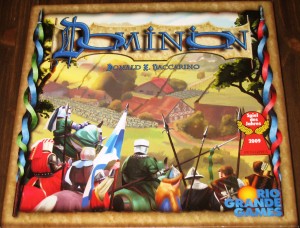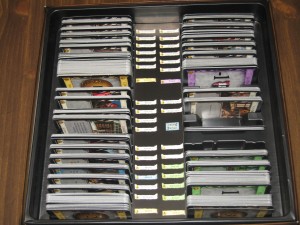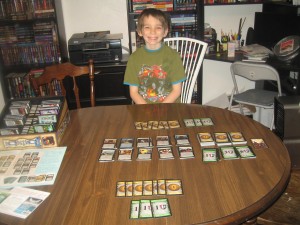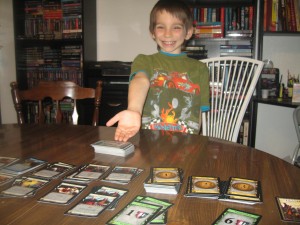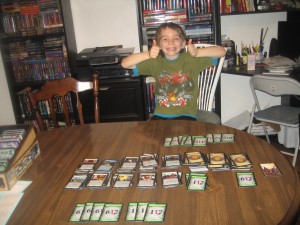I mentioned in a recent review that Carcassonne was the first tile laying game that I’ve ever played. It just so happens that I’m now writing about a game that was my first deck building game. A deck building game, to put it simply, is a game where players start off with a small amount of cards and use said cards to acquire more from a pool of purchasable cards. Each player’s deck is constantly growing in size throughout the game until a specific condition forces the game’s end.
In “Dominion”, players will be doing just that…that is…start off with a few cards, build their deck, and try to win the game. Let’s take a look at the setup and gameplay before heading into the review. I normally do a section dedicated to components, but seeing as how the only component type is cards, I’ll opt to skip it. I will mention however that treasury cards allow you to buy new cards, victory point cards are vital to winning the game, and kingdom cards give you special abilities to use while playing the game.
For review purposes, I’ll cover the gameplay briefly…but if you are interested in learning more, you can find the full manual here: Dominion Manual.
Setup
1) Place the treasure and victory cards within easy reach of all players. Depending on how many players are playing, you’ll limit how many victory cards are placed in each victory pile. The trash card should be placed near these piles.
2) Players will decide on ten kingdom card decks to use in the game, or opt to use the suggested set of decks found in the manual. There will be ten cards per deck. Place these decks face up near the treasure and victory cards. If any of the kingdom cards involve curses, place the curse cards near the treasure and victory cards.
3) Each player receives seven copper treasury cards and three estate victory cards, which makes up their starting deck. Choose a player to start the game, and each player draws five cards from their ten card starting deck.
Gameplay
Each player will take turns performing particular actions, which are described as follows:
1) Action Phase: Play a kingdom card with an action on it. If it so happens that the card you play allows more actions, then keep going until you are out of actions.
2) Buy Phase: Using any treasure cards in your hand, purchase an action card, treasury card, or victory card from the available pool. The cost of the cards vary and are indicated on the individual cards. You can only purchase one card, though some action cards may allow you to buy more during that turn.
3) Clean-up Phase: All cards from your hand, along with any cards you used and purchased during this turn, are discarded into your discard pile. Draw five new cards for your next turn. If you run out of cards to draw, shuffle your discard pile and draw what you need.
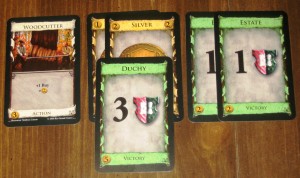
In this example, I played a woodcutter card during my action phase. During the buy phase, I purchased a duchy victory card using treasury cards valued at three, plus the two from the woodcutter. The cards on the right I didn’t use. All of these cards are then placed in my discard pile, and five more cards are drawn.
Players continue taking turns in this manner until the province victory card pile becomes empty, or a total of three supply decks have been used up. After this occurs, players will count up how many victory points they have in their total deck…the player with the most wins.
The Review
Just a word of warning, the game can take much longer than a half an hour if players aren’t in any hurry to meet the game end conditions. This happened to my eleven year old son and me…we were so caught up with building our deck that we often lost sight of what our true goals actually were. That’s not to say that we didn’t have fun.
Play can flow very quickly if all of the players are familiar with how the kingdom cards function. Newer players will need to spend some time going over them, especially when they go to play them during the action phase. One action card could lead to two more, then those could lead to this this and this…it can be overwhelming to the easily intimidated. For the record, my son had no issues keeping track of the chain of cards he was playing and at times, I lost track of what was going on. He was having fun, so if he made a mistake, so be it.
The game has a lot of replayability due to the vast amount of kingdom card deck combinations players can use when setting up the game. My son and I stuck with the beginner set of decks to keep things simple, but experienced players will no doubt develop their own set combinations to make the most out of their play experience.
Overall, my son and I enjoyed our first deck building experience. It’s simple enough that it allowed us to pick up the gameplay quickly, but strategic enough to keep us constantly thinking on what cards we should play with every new hand we were dealt. The game is flexible enough that it allows us to change the game ending conditions, in case we don’t have a lot of time to play.
If you are a fan of deck building games or want to expand your palette, I’d advise giving this game a look. This game would also serve well in introducing new players to the genre.
Final Verdict: 7/10
—

